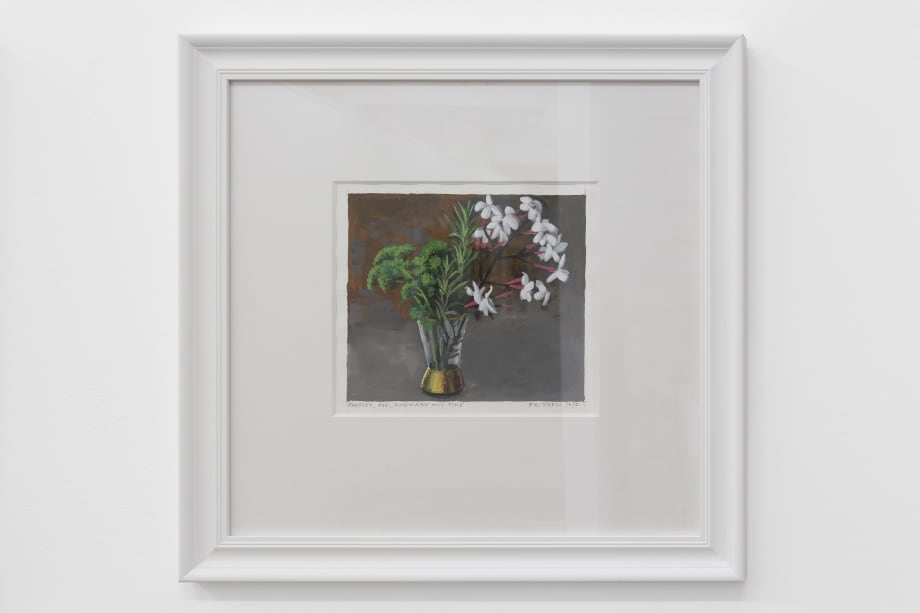Dick Frizzell's exhibition began with a painting of a single vase of flowers. ‘Return to Order’ speaks to the highs and lows of the artistic process, the emergence of style, the joy of painting, and its sometimes unexpected outcomes.
An intelligent young person’s guide to Dick Frizzell’s florals
by Dr Mark Stocker
A favourite pop singer of mine, and you can tell how hip I am, is Andy Williams. One of his many fine hits was ‘And Roses and Roses’ (1965), set to a bossa nova beat. I was forcibly reminded of this ditty when I beheld the iconography of the latest efflorescence in paint by Dick Frizzell. Not just roses, but freesias (my favourites), delphiniums and antirrhinums too – plus the odd bowl of fruit. They are hard to miss and there is no mistaking what has been on Frizzell’s mind and eye in recent months. They are painted with full on, hard-edged gusto, without a trace of tremulous Expressionist anger or angst about them. Frizzell has cast himself in the mould of the post-Fauve André Derain who rejected his youthful outpourings and became a wholehearted upholder of the splendidly conservative ‘return to order’ that characterised some of the best modern art of the 1920s. It represents a major revival of the classical tradition that had gathered momentum in World War One, and affected others beside Derain – Picasso, Léger, Italian Futurists and particularly Giorgio di Chirico, who never really painted anything serious that wasn’t in this vein. I remember being blown over by the exhibition that showcased these artists, ‘On Classic Ground’, at the Tate Gallery in 1990, where I said to myself: ‘Now, this is how these guys should always have painted’.
From the works here, Frizzell clearly agrees with me, his youthful tomfoolery now firmly consigned to the ‘little rotter’ bin of the past. A strong sense of line, the probity of art as Ingres called it, solidity and discipline all permeate these works. One arrangement, which features roses, an alstroemeria (I think, it’s a great name to drop anyway) and ferns is placed in an austere, off-white glazed vase that would have delighted Derain himself. In other works, Frizzell obviously enjoys the challenge of transparent vases and producing order out of the chaos of stems. These are apparent, for example, in two larger paintings of roses, set more than a little surrealistically against dramatic skies and seascape backgrounds, one featuring Rangitoto. This strange manipulation of scale surely shows Frizzell’s awareness of the later work of British painter Edward Wadsworth.
Enough art historical name-dropping for the time being. An important horticultural question is this: have Frizzell’s stem ends been clipped diagonally to prolong their vase life? If not, why not? I must bespeak them at closer quarters to confirm this and admonish the cowering artist if not. Constance Spry (1886–1960), florist extraordinary, would do no less. The era to which Frizzell affectionately harks back represents the Spry era, indeed the zenith of flower arrangements in our 20th century culture: it evokes the church florals, which my fabulous Aunty, Audrey Stocker (an English rose of 94), would produce for Kilburn Parish Church till relatively recently; and those cut-throat horticultural society and A & P flower shows of yesteryear, epitomised by the Dowager Countess of Grantham and her prize roses in Downton Abbey. This is a world that is fading, but happily Frizzell’s flowers are in full, defiant bloom, without exception almost indecently vigorous – yet tamed and controlled by his intellect and ultimate pictorial discipline.
Floral painting is underrated in Aotearoa New Zealand. Colin and Gordon didn’t paint enough roses; Milan, Ralph and Billy didn’t really help much either. But who did? The answer is a pretty impressive roll-call: Margaret Stoddart and A.H. O’Keefe win this judge’s first prize – though I love Rita Angus’s rather more conservative watercolour offerings too. Then there’s Frances Hodgkins, whose later flowers can be a weird modernist deformity or mess, though not without investor appeal, and Cubist florals from Louise Henderson. And there’s Rita’s contemporary Rata Lovell-Smith, the underrated Elizabeth Stevens and more recently the right-on Jude Rae, not to mention the blooming brilliance of Karl Maughan. Te Papa take note – such an exhibition would be a killer, and Frizzell (for whatever reason not hugely favoured by this supposedly populist institution) would handsomely hold his own in such exalted company. Not convinced by flower power? Then I pity you. Stop and smell the roses, enjoy the pleasant things in life. You can make a good start with these paintings.

